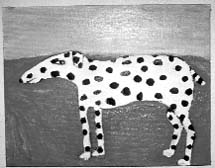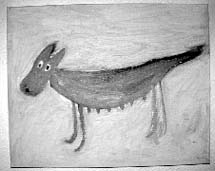Family portrait
Alison Alder asks the questions
Brenda Runnegar is an artist and the Manager of Anyinginyi Arts here
in Tennant Creek. Emma Kelly, also an artist and Brenda's daughter,
has been visiting and I asked them about their art and the differences
between horses and dogs ...
Brenda: I became interested in art when I was 14 or 15 years old. I
had a vocational guidance at school who said, "Whatever you do
don't do art!". So I did Latin instead, as he suggested! But as
soon as I left school I started learning art, mainly from artists. I
didn't go to art school until much later.
They used to have these crazy art lessons in Brisbane, back in the sixties,
where they would bring along a bottle of sherry and have a life model
there. The artist was John Molvig, who was teaching life drawing. That
was illegal because you weren't allowed to have live models in those
days, so they used to get a prostitute off the street and the price
of the class was to pay for the model.
It made a very interesting way to start art and Molvig was a fantastic
teacher, the best I have ever had, so that is how I started. Then I
learnt oil painting from another artist in Brisbane, I used to go one
or two nights a week. I went to London in 1970 and I decided to take
up weaving, the fibre business was starting in the 70s. My son, Chad,
was born in London and I used to swap babies with someone else and learnt
spinning and weaving in a very traditional way. In the 70s it was all
a new movement of sculpted fibre works.
I did that for about 10 years probably. I was quite successful, I had
solo exhibitions and I was invited to exhibit in Poland. I did really
interesting workshops run by artists from overseas and I became quite
well known.
In the early 80s I decided that I wanted to switch to painting. I don't
know why exactly. I think one of the reasons was that fibre work was
so time consuming. I had this big commission to do for the NCDC (National
Capital Development Commission) in Canberra, and I did a big work for
the Woden Valley Hospital that took six months. I had to spin a bale
of wool and dye it all on the barbeque, it was a huge fibre work and
I got very little money for it. I decided that I really wanted to do
painting which is a much more direct way of working and wasn't so time
consuming. In the early 80s I went to the Canberra School of Art, and
started painting.
I got a diploma in those days. It was like a metamorphosis. I used to
make sculptures that were painted on, out of soft fabrics, like pillows
and cover them in plaster, so they were still sculptural but I wasn't
painting on canvas.
BNP: What did you think of Brenda's work when you were growing up Emma?
Emma: I was quite impressed with the scale of the weavings, they seemed
really big and colourful and tactile. A lot of stuff that she did at
art school was pretty disturbing.
Brenda: Just because I collected dead birds.
Emma: I thought it was fine, my Mum has always done her own thing.
BNP: And did you friends think it was odd, a mother collecting dead
birds?
Emma: No they just accepted it, no-one said anything about it.
Brenda: At the time I was going through a marriage break up so my work
was a bit disturbing. It was a bit therapeutic for me in those days.
I had a solo exhibition at Bitumen River Gallery just after I graduated.
I was looking after the exhibition and someone came to the door, looked
in and said that whoever did this show needed to see a psychiatrist,
I couldn't own up to it at that stage and just said, "Oh I think
she's OK".
Over the years my work has become less and less three dimensional and
now I am painting on canvas.
I went back to art school in 1995 to upgrade to a degree and that is
when I really wanted to do painting and I forced myself to just paint.
I am continuing and really enjoying that now.
BNP: What is your work about now?
Brenda: For the first time it is not so distressing - in fact it is
quite frivolous. My work is about how disturbing I find all the dogs
around Tennant Creek and how gruesome and upsetting it is. But I am
doing it in a frivolous way. I have become the opposite to how I was
working before, when I was a happy person doing all this distressing
work.
BNP: So now you are a distressed person doing all this happy work?
Brenda: Yes it must be! What they taught me at Queensland College of
Art is not to be quite so personal. Not to make everything a personal
statement - look around and talk about other things.
I also see character in the dogs and I have tried doing other animals
but they don't have the same rapport as the dogs. Dogs have such personalities
in their faces. When I was in Melbourne I went to Niagara Gallery where
they have John Kelly's work, he only paints cows. I realised how far
I really can take it.
BNP: So we have a lot more dogs to see yet?
I reckon.
BNP (to Emma): How did you get started in animating?
Emma: I studied graphic design, I did a diploma at the Canberra Institute
of Technology and by the end of it I was a bit sick of it. In Canberra
I could see what the top graphic design studios were like but it didn't
appeal to me. I didn't know where to go. One day Mum found an ad in
the paper for an animation course in Melbourne at the Victorian College
of Art and said I should apply for that and see what happens. So I did
and I got in.
Brenda: It was quite an achievement to get in - they only took twelve
people from the whole of Australia.
Emma: I had to do a story board and a proposal of what kind of film
I wanted to make. The whole course evolves around making a whole film.
BNP: What was that first story board about for your initial application?
Emma: It was quite tiny, a simple black and white drawing in charcoal
pencil with two eyeballs which were asleep. They were quite separate
from each other and they both woke up and one of them had a set of wings
and it flew off and the other eyeball watched it fly away. It then turned
back to the camera and was blinking and crying.
BNP: So, what did that say about your emotional state?
Emma: I don't know, travel? I don't know which eyeball I was supposed
to be!
BNP: So you did that course, and it was obviously very good and set
you on your path?
Emma: Yes, as soon as I finished it I got a job at Animation Works and
have been doing it ever since.
BNP: How long is that?
Emma: About five or six years now.
I incorporate both hand drawn and computer imagery. Initially at Animation
Works they would use the computer to composite, to bring together three
dimensional backgrounds and two dimensional characters. Or they would
use the computer to paint all the drawings. All the animation was done
by hand though.
Now I am working for a lady called Sarah Watt who is an independent
film-maker. She has funding to make a short film from the AFC (Australian
Film Corporation) and SBS. I am privileged enough to work on that with
her.
When I was at Animation Works I was very much a hired hand, you just
churn it out, slog out the drawings, hundreds a day. More quantity rather
than quality.
Sarah's work is more painterly. She hand paints everything and hand
renders all the cells. She gives me a scribble and says this is kind
of what I want, but you figure it out and do it how you think. It is
really good, giving me some input.
It will be released toward the end of 2001 and is in a series called
Home Movies on SBS. The title of the one I am working on is Living With
Happiness.
BNP: Brenda, how has your work as an artist affected the work you do
with Aboriginal artists?
Brenda: The Aboriginal artists have contributed a lot to my art practise.
The way for instance that Peggy Jones works really casually and easily,
with a lot of colour. Her use of colour has had a big influence on me.
And then on the other hand, because I have worked for a number of years
in the art world, and visited many galleries and exhibitions, I can
contribute by knowing what will appeal to the gallery scene.
In the past Anyinginyi often haven't bought work because it wouldn't
appeal to the tourist market and yet artists in this area are producing
work that would appeal to the gallery market. One of the reasons I have
managed to get this touring exhibition together is that I want to highlight
the strengths of those artists who have been overlooked for a number
of years.
BNP: Do you think your mother being an artist made it an easy transition
for you to become an artist Emma? A lot of parents might not think that
a career in the arts is a good idea, not stable, no money, etc.
Emma: Yes definitely. From the year dot I have been drawing and it has
always been there, I never really thought anything about it. I used
to wonder what other kids did in their spare time if they didn't draw.
Brenda: Emma started drawing horses when she was three years old and
could barely hold a pencil. The first job she had at Animation World
was to do a whole series on the Silver Brumby. I couldn't believe that
she got a job drawing horses - she had been practising for it since
she was three!
Emma: When I went for the interview for the job I didn't have any pictures
of horses in my portfolio. I said, "I can really draw horses, trust
me, I can draw horses"..




A couple of dogs from
Brenda's Camp Dog series.